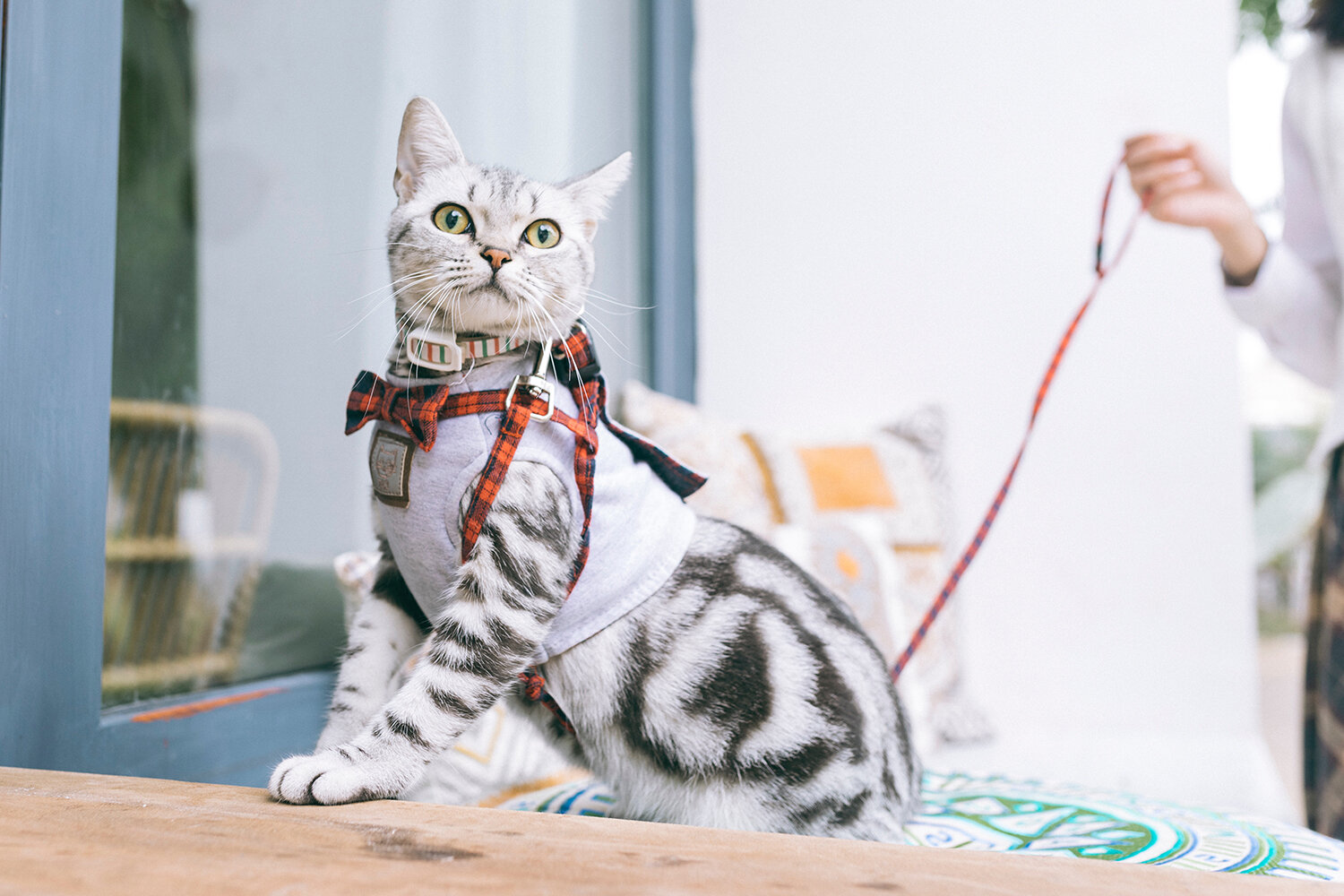How To Harness Train A Cat
One of the first steps in training your cat to explore with you is to train your cat to wear and walk in a harness.
Why?
Because a harness is a great way to keep your cat under your control while walking them on a leash.
But can’t I walk my cat by attaching their leash to the collar instead?
Your cat may be used to wearing a collar, but we always recommend that you only attach a leash to a harness.
If you attach the leash to their collar, and they make some sudden movement or are spooked while you are out and about, the leash will tug on their collar. This can cause some serious injury and even death via strangulation.
A harness spreads out the pressure and doesn’t tug on your cat’s neck.
Training Your Cat to Wear a Harness
There are several ways to train your cat to wear a harness and we asked our community how they trained their cats.
Positive Reinforcement
Cats respond to positive reinforcement training.
Positive reinforcement is when you reward your cat for displaying a positive behaviour. When harness training, this could be walking while wearing the harness.
As cat owners, we need to understand what rewards our cats respond to. These may be treats, toys, games, pats or praise. These are the rewards that you use to encourage your kitty to wear their harness.
Another great form of positive reinforcement is clicker training, which we discussed on the Catexplorer Podcast!
Harness Training Your Cat at Home
Purchase a Harness
The first step in harness training is to purchase a harness for your cat. We have listed what you should consider and harnesses with their pros and cons here.
Our suggestion is to start training with a H-harness. If you’re uncomfortable with how secure a H-harness is, use a more secure harness after your cat becomes comfortable with the H-harness.
Positive Association with Their Harness
Once you have purchase the harness, it is time to start creating a positive association with the harness while you are still inside, at home.
The easiest positive association method is to use treats. However, if your cat is not food motivated, you can also use play, pats and praise.
Introduce your cat to their harness by letting them sniff it. Each time they sniff the harness, provide them with a treat. This process may require a few short sessions.
Introducing the Harness to Your Cat
As your cat becomes comfortable with their harness, start putting it on them.
Depending on how comfortable your cat is with the harness you can either secure the harness on them or just place the harness on top of their body.
Each time you do this, provide your cat with a treat.
If you have started with placing the harness on your cat, once they have become comfortable with this, secure the harness on them and provide them with a treat.
Harness Training Timing
Our suggestion is to start with short session, like 1 – 5 minutes and slowly extend the session to a longer period of time like 30 minutes.
It would be ideal to do this every day. Consistency will go a long way when training your cat.
Depending on your cat’s personality, we suggest that you give them their reward (like treats or food) at the end of each session, especially as the time period gets longer.
If Your Cat Refuses to Move While Wearing Their Harness
Think about it. You’re used to wearing nothing on your body and then suddenly someone puts clothes on you – wouldn’t that feel odd?
That’s exactly what our cats may feel when we first introduce them to their harness.
So much so, that it is common for cats to freeze, drop to their side and not move.
It’s because they aren’t used to the sensation of wearing a harness and they don’t know how to react to it.
If your cat does this, don’t despair. We just need to show them that they can actually move while wearing a harness.
An easy way to do this, is to play with them while they are wearing their harness. Choose one of their favourite wand toys and encourage them to chase it. Before long they will forget that they are wearing the harness and will be chasing you around your home.
A few sessions of this and they will begin to get used to the odd sensation of wearing a harness.
Other Harness Training Tips While at Home
We suggest starting to harness train your cat as soon as they join your family. Generally kittens are easier to train, but if you do have an older cat, it is still possible to train them.
While fitting your cat’s harness, we suggest ensuring that you can fit 2 fingers next to each other between the harness and your cat’s body. If you can’t fit them, the harness is too tight. If you can fit more, the harness is too loose.
We also love the idea of using specific treats or toys that are only used for harness training. This will help your cat associate the harness with these and create an even more positive association. In the future you can also keep these treats for just exploring too.
If your cat’s harness requires their head to go through the harness, you can use a treat to guide their head through. Repeat this a few time over a few days till they are comfortable with putting their head through.
Other Cat Training Skills for Exploring
While harness training is very important for exploring, we also recommend that you train your cat a few other skills like sit, stay and come.
We know what you’re thinking – isn’t it just dogs that can do this?
But cats can to. In fact they can do a lot more.
And knowing these behaviours will make exploring with your cat a lot easier and safer. You can tell your cat to ‘sit’ or ‘stay’ when danger is approaching and ‘come’ is useful when you need them to leave an area.
An easy way to train these behaviours is by using clicker training.
Going Outside With Your Cat
Once your cat has become used to their harness while you are inside, you can start going outside with them.
Location Location Location
When you cat becomes comfortable with their harness, it can be really tempting to go straight into hiking in the mountains.
However, ‘jumping’ in the deep end, doesn’t really work when training a cat. Our recommendation is to take baby steps (or should we say kitten steps?).
The first location you go outside with your cat should be one that you are comfortable with. That you can control and keep your cat safe.
Great options are a balcony, a courtyard, a backyard, an apartment corridor. Somewhere without a lot of stimuli, people, animals or sounds. A place where you can focus on your cat.
Training Time
Like with harness training indoors, we recommend that you just start with a short period of time outside and then slowly increase this time.
However, this also depends on your cat. If they are having a lot of fun, it may be ideal to stay outside longer.
Harness = Outside Fun
Some cats never really grow to love their harness while they are wearing it indoors and no amount of treats will change their mind.
However, these cats may grow to love their harness if they start to associate it with going outside.
If your cat struggles with their harness while indoors, it is during this training time that they will develop an understanding that the harness = having fun outside.
Distraction
When you first start training your cat to go outside while wearing their harness, it is possible that they won’t follow the verbal commands that you have been teaching them inside, like sit, stay and come.
It is likely that your cat is distracted by all the new stimuli outside and the last thing they want to do is sit.
Don’t despair if this is the case. Practice these commands while you are outside and your cat will start listening to them over time.
Safe Space
We strongly recommend that you have a safe space for your cat to retreat into while exploring. A safe space can be a backpack or a stroller or even your home.
This step in harness training is also a great time to start introducing your cat to understanding and using their safe spot when they feel scared or anxious.
Introducing More Stimuli
When your cat becomes comfortable with being outside with you while wearing a harness and on a leash, you can start introducing them to locations with more stimuli.
We suggest doing this slowly. For example, move from your balcony to your courtyard/backyard and then to your front yard.
Once your cat has mastered the front yard, perhaps you can move to a quiet local park, then one that is a little busier. Another idea is to start exploring at a park when it isn’t popular (like early in the morning) and then slowly start exploring the park as it gets busier.
This way, your cat is being introduced to new stimuli slowly and adapting.
This also gives you the opportunity to watch your cat and understand whether you are pushing them beyond their boundaries.
If they are comfortable with it, over time you can introduce them to situations with more stimuli, people, animals, noises and more.
Harness Training Your Cat in Winter
If you have introduced your cat to your family in winter, we understand that you may not want to train them to walk on a harness and leash in the cold.
Instead of waiting till spring to harness train your cat, you can still start the process while the weather is cold.
If you live in an apartment building, a great place to start introducing your cat to the ‘outside world’ is in the hallway. However, before you do this, we suggest ensuring that your cat is allowed to walk in the hallway. Some apartments have a rule that states that pets are not allowed to walk on common property and must be carrier.
If you live in a house, rather than taking your cat outside, you can open the door and sit with them (while they are wearing a harness and leash) and let them watch the outside world. This gives them the opportunity to experience what it entails, but from a distance.
Removing the Harness
At the end of an adventure, your cat may not be cooperative when you are trying to take off the harness.
In order to reduce this, you can create a post walk routine. This may include a treat that they receive once you are home and have removed their harness. Or it can be a rule where they cannot leave their backpack or stroller till their harness has been removed.
Consistency & Patience
As with any type of cat training, harness training your cat requires a lot of patience and consistency.
A regular routine with shorter sessions will go much further than a longer session every so often.










Find the best cat backpack for your cat’s adventures